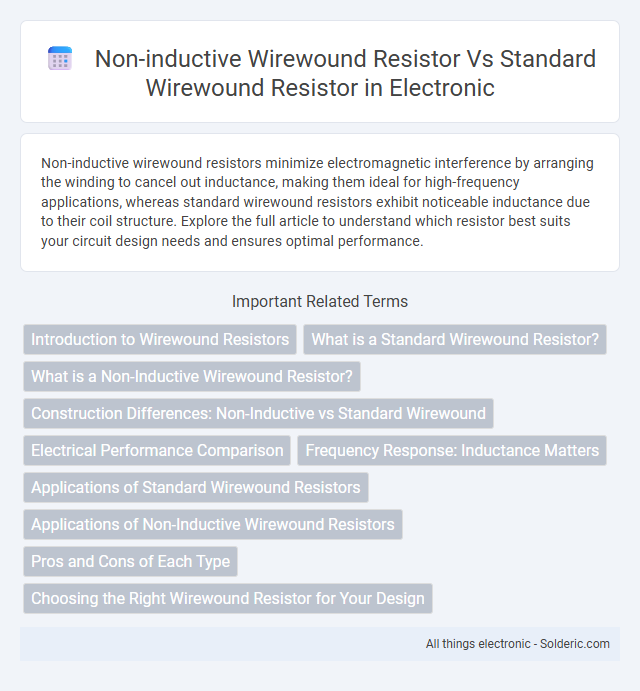Non-inductive wirewound resistors minimize electromagnetic interference by arranging the winding to cancel out inductance, making them ideal for high-frequency applications, whereas standard wirewound resistors exhibit noticeable inductance due to their coil structure. Explore the full article to understand which resistor best suits your circuit design needs and ensures optimal performance.
Comparison Table
| Feature | Non-inductive Wirewound Resistor | Standard Wirewound Resistor |
|---|---|---|
| Inductance | Minimal to none due to bifilar winding | Significant inductance from coil winding |
| Applications | High-frequency circuits, precision current sensing | Power dissipation, general load resistors |
| Frequency Response | Stable at high frequencies | Degrades at high frequencies due to inductance |
| Power Rating | Typically lower than standard wirewound | Higher power ratings available |
| Cost | Generally higher due to complex winding | Lower cost, simpler construction |
| Precision | High precision with stable resistance | Good precision but inductive element may affect performance |
Introduction to Wirewound Resistors
Wirewound resistors consist of a metal wire, typically nichrome, wound around an insulating core to provide precise resistance values with high power ratings. Standard wirewound resistors exhibit significant inductance due to the coil shape, which can affect high-frequency performance. Non-inductive wirewound resistors are designed by winding wire in a bifilar or Ayrton-Perry pattern to cancel inductance, ensuring stable resistance and minimal reactance for high-frequency applications.
What is a Standard Wirewound Resistor?
A standard wirewound resistor consists of a resistive wire wrapped around an insulating core, designed to handle high power and provide precise resistance values. It typically exhibits significant inductance due to the coil-like winding, which can affect performance in high-frequency applications. Your choice between standard and non-inductive wirewound resistors depends on whether inductance impacts your circuit's functionality.
What is a Non-Inductive Wirewound Resistor?
A Non-Inductive Wirewound Resistor is designed to minimize inductance by winding the resistive wire in a bifilar or closely coupled manner, effectively canceling out magnetic fields generated by current flow. Unlike standard wirewound resistors, which exhibit significant inductive reactance due to their helical winding, non-inductive types maintain stable resistance and frequency response in high-frequency or transient applications. This makes Non-Inductive Wirewound Resistors essential in precision electronics, RF circuits, and test equipment where inductance can distort signal integrity.
Construction Differences: Non-Inductive vs Standard Wirewound
Non-inductive wirewound resistors feature a bifilar winding technique where two wires are wound in opposite directions to cancel out inductance, whereas standard wirewound resistors use a continuous single coil resulting in higher inductance. The non-inductive design reduces parasitic inductance, making them ideal for high-frequency and precision applications. Standard wirewound resistors, constructed with a helical coil on an insulating core, generally offer higher power ratings but are less suitable in environments sensitive to inductive reactance.
Electrical Performance Comparison
Non-inductive wirewound resistors offer superior electrical performance by minimizing inductance, which allows for higher frequency applications and reduces signal distortion compared to standard wirewound resistors. Standard wirewound resistors typically exhibit higher parasitic inductance due to their helical winding, resulting in less accuracy and stability at high frequencies. Consequently, non-inductive designs are preferred in precision circuits, RF applications, and where low noise and stable resistance values are critical.
Frequency Response: Inductance Matters
Non-inductive wirewound resistors are specifically designed to minimize inductance, making them ideal for high-frequency applications where standard wirewound resistors' inherent inductance can cause signal distortion and performance degradation. The tightly wound, bifilar construction of non-inductive resistors counteracts magnetic fields, resulting in a flat frequency response and stable resistance values across a wide frequency range. Standard wirewound resistors, with their single-layer coil design, typically exhibit higher inductance, limiting their effectiveness in RF circuits and precision measurement devices.
Applications of Standard Wirewound Resistors
Standard wirewound resistors are widely used in applications requiring precise resistance values and high power dissipation, such as power supplies, motor controls, and audio equipment. Their ability to handle substantial current and operate under high voltages makes them ideal for load testing and current sensing. If your project demands durability and stability in harsh environments, standard wirewound resistors offer reliable performance despite their inherent inductance.
Applications of Non-Inductive Wirewound Resistors
Non-inductive wirewound resistors are ideal for high-frequency and precision applications such as RF circuits, oscillators, and signal processing where minimizing inductance is crucial for accurate performance. These resistors maintain stable resistance under high pulse loads and reduce parasitic inductance that could distort signals in sensitive electronic components. Your choice of non-inductive wirewound resistor ensures optimal functionality in test equipment, audio devices, and high-speed digital circuits requiring precise, low-inductance resistance.
Pros and Cons of Each Type
Non-inductive wirewound resistors offer superior performance in high-frequency applications due to their minimized inductance, making them ideal for precision circuits, though they tend to be more expensive and less readily available than standard wirewound resistors. Standard wirewound resistors provide excellent power handling and stability at a lower cost but can introduce unwanted inductance, which may affect signal integrity in sensitive or high-frequency environments. Understanding your application's frequency and precision requirements helps determine the appropriate resistor type, balancing cost with performance effectively.
Choosing the Right Wirewound Resistor for Your Design
Non-inductive wirewound resistors minimize magnetic interference by winding the wire in a bifilar or segmented pattern, making them ideal for high-frequency applications and precision circuits. Standard wirewound resistors, with their single-layer coil construction, offer higher power ratings but can introduce inductance that affects signal integrity in sensitive designs. Selecting the right wirewound resistor involves balancing power rating, inductance, and frequency response to ensure optimal performance in your electronic circuit.
Non-inductive wirewound resistor vs standard wirewound resistor Infographic

 solderic.com
solderic.com